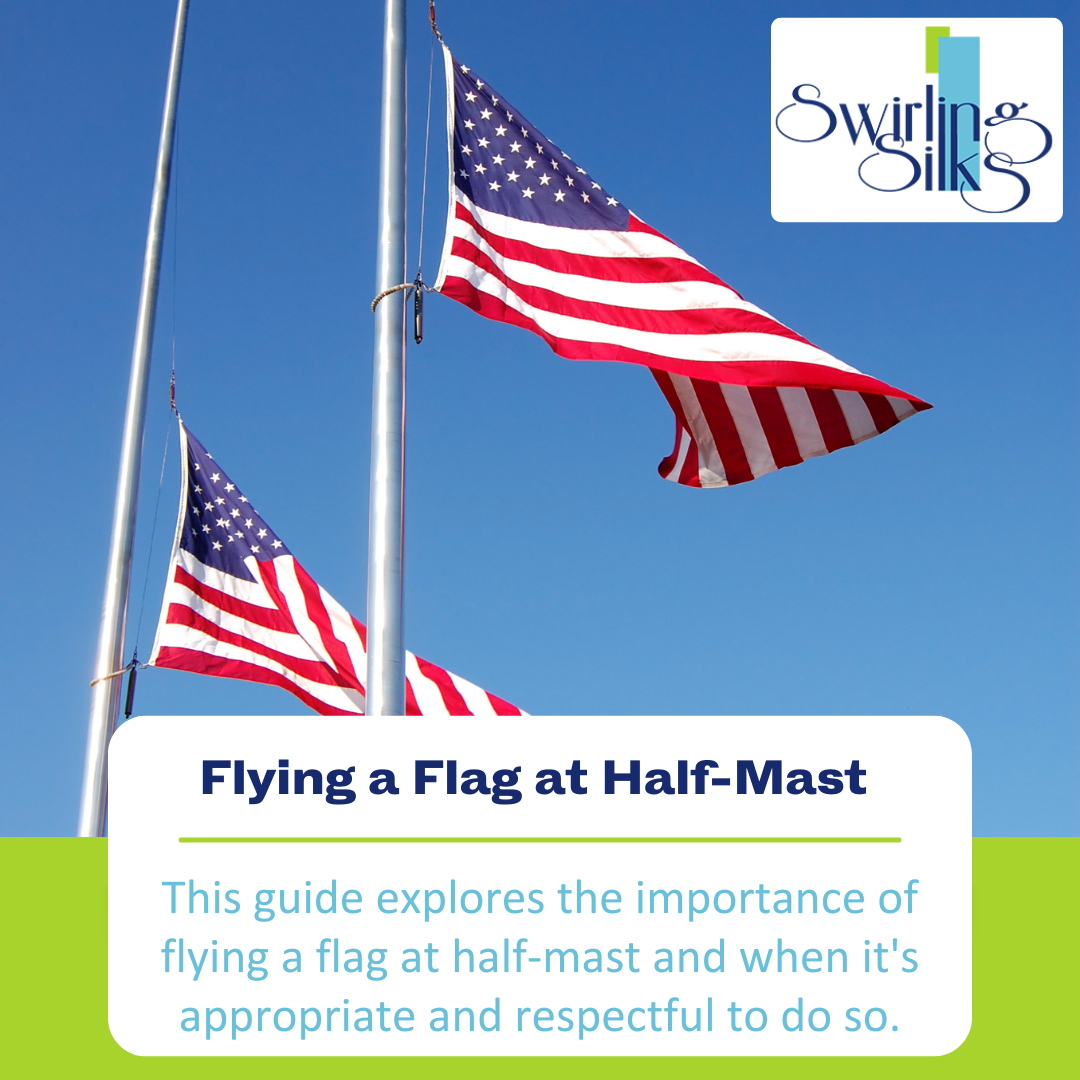Swirling Silks recognize flags are powerful symbols that represent a nation’s identity, values, and unity. While our company manufactures custom flags and customized banners as part of our routine work, we occasionally get requests from clients on how best to display them.
One way to convey a message of respect, mourning, or solemnity is by flying a flag at half-mast. This practice carries significant meaning and serves as a universal symbol of collective grief, tribute, or remembrance. In this guide, we’ll explore the importance of flying a flag at half-mast and when it’s appropriate and respectful to do so.
Contact Swirling Silks to Discuss Your Flag Designs
Why Do We Fly a Flag at Half-Mast?
Flying a flag at half-mast carries significant symbolism, and it’s essential to understand why flags are lowered in this manner. There are three primary reasons for flying a flag at half-mast:
- Tribute and Mourning: One of the most poignant reasons for lowering a flag to half-mast is to pay tribute to individuals or groups who have passed away. This act serves as a visible sign of respect and sympathy for their loss.
- National Mourning: In times of national tragedy or widespread sorrow, such as the death of a prominent leader or a national disaster, flags are lowered to half-mast. This gesture conveys the collective grief and unity of the nation in the face of adversity.
- Remembrance: Flags at half-mast also serve as a solemn reminder of historical events or significant anniversaries. This ensures that we never forget the sacrifices made by those who came before us, preserving the memory of important milestones in our history.
8 Occassions to Fly Flags at Half-Mast
In addition to the aforementioned core reasons, here are eight specific occasions when flags are flown at half-mast:
Death of a Prominent Figure
The most common reason to fly a flag at half-mast is to mark the death of a prominent national or international figure, such as a head of state, government official, or a respected public figure. Flags may remain lowered for a specific period, often based on protocol or tradition.
National Tragedy
Flags are lowered to half-mast in the event of a national tragedy, such as a terrorist attack, natural disaster, or a mass shooting. This shows solidarity and shared grief as a nation mourns the loss of life.
Memorial and Remembrance Days
Many countries have designated memorial or remembrance days, such as Memorial Day in the United States or Remembrance Day in Canada and the United Kingdom. On these days, flags are typically lowered to honor fallen soldiers and war veterans.
Anniversary of Significant Events
Flags can be flown at half-mast to mark the anniversary of significant historical events, like the attacks on September 11, 2001, or the end of World War II. This practice ensures that these events are never forgotten.
Funeral Services
Flags are often lowered during funeral services to honor the deceased, especially when the person was a veteran, first responder, or public servant.
State Mourning
In some cases, a state may declare an official period of mourning, during which flags are lowered throughout the jurisdiction. This can occur for various reasons, such as the death of a monarch or a significant event in a state’s history.
International Gestures
Countries may lower their flags as a sign of respect and solidarity with other nations during times of international mourning, such as the death of a foreign leader or a tragic event affecting multiple countries.
Personal Tributes
Individuals may choose to fly their flags at half-mast in their homes or businesses to commemorate the passing of a loved one or to express their feelings of sorrow and respect.
Understanding when and why flags are flown at half-mast is a meaningful way to participate in the collective expression of grief, remembrance, and respect.
Request a Free Customized Flag Design Quote
Dates to Fly Half-Staff in America
The following is a list of scheduled days when the US Flag is to fly at half-staff:
- By order of the President of the United States
- By order of the Governor of your state
- Peace Officers Memorial Day, May 15th (sunrise until sunset)
- Memorial Day, last Monday in May (sunrise until noon)
- Patriot Day, September 11 (sunrise until sunset)
- Korean War Veterans Armistice Day, July 27th (sunrise until sunset)
- National Firefighters Memorial Day, first Sunday in October (sunrise until sunset)
- Pearl Harbor Remembrance Day, December 7th (sunrise to sunset)
Half-Mast Flag Etiquette
When flying a flag at half-mast, there are some important etiquette guidelines to follow:
- Lower the flag to half-mast briskly and with respect.
- The flag should be hoisted to the peak before being lowered to half-mast and raised to the peak again before lowering it fully.
- Ensure that the flag is positioned at exactly half the distance between the top and bottom of the flagpole.
- When the flag is at half-mast, no other flag should be placed above it on the same pole. If multiple flags are displayed on the same pole, they should be lowered to half-mast together.
- Flags flown at half-mast should remain in that position from sunrise until sunset. However, some situations may call for a specific period of mourning, as determined by the governing authority.
Read Tips for Displaying the US Flag
Why We Fly the Flag at Half-Mast
It’s important to understand the symbolism of why flags are flown at half-mast. Avoid improperly displaying your flag by recognizing these three key reasons of a half-mast flag:
- Tribute and Mourning: Flying a flag at half-mast is a poignant way to pay tribute to individuals or groups who have passed away. It is a visible sign of respect and sympathy for their loss.
- National Mourning: When a nation experiences a tragedy or loss on a large scale, such as the death of a prominent leader or a national disaster, flags are lowered to half-mast to convey the collective sorrow and unity of the nation.
- Remembrance: Flags at half-mast serve as a reminder of historical events or significant anniversaries, ensuring that we never forget the sacrifices made by those who came before us.
Get Expert Flag Designs and Assistance
Swirling Silks understands that flying a flag at half-mast and observing proper flag etiquette are a powerful and symbolic way to convey respect, mourning, and remembrance. It is a universal gesture that transcends borders and languages, allowing people to come together in times of grief and loss.
Swirling SIlks has 30+ years of experience in bringing great designs to life on custom flags, banners, festival event signage, exhibits, billboards, murals and graphics for both interior and exterior. If you can imagine it, its likely we’ve helped another customer with something similar. Let us put our resources to work for you with your next project.


